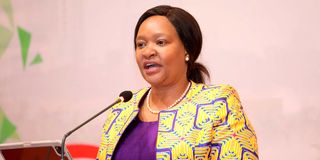Premium
Report: Low tax incomes messing county finances

Investments, Trade and Industry Cabinet Secretary Rebecca Miano during the launch of the Commission on Revenue Allocation's tariffs and pricing policy in Nairobi on June 18, 2024.
What you need to know:
- There is a huge gap between actual and potential revenue collection by counties.
- Counties earn money through property rates, parking fees and trade permits.
Stagnation and decline in own source revenue (OSR) collection continues to mess up finances for the 47 counties, leaving the devolved units at the mercy of the National Treasury whose exchequer releases are unreliable and inadequate.
A conference on counties’ OSR collections in Nairobi was on Wednesday told by finance experts that there is a huge gap between actual and potential revenue collection by the regional governments, meaning they can fund a higher share of their services if the potential is realised.
Counties earn money through property rates, parking fees, trade permits and other taxes.
The forum held at the Kenya School of Monetary Studies heard that increasing the OSR collection efficiency remains crucial in enhancing public service delivery.
Ms Christine Owour, a public sector specialist working with the World Bank, said the domestic revenue shortfalls have occasioned fiscal deficits made worse by high pending bills and bloated recurrent expenditures.
The official said some counties continue to dig themselves into deeper financial holes through wasteful spending, adding that the World Bank, through the Sh200 million second phase of the four-year Kenya Devolution Support Programme, will support capacity building and technical assistance in counties.
“The OSR is mostly below what is planned and the respective counties' potential. Enhancing that collection should be the top priority. As the World Bank, we have pledged to disburse $500,000 (Sh64,630,000) annually to the counties if they increase their OSR collections by five percent, update their revenue streams, use automation and if their revenue registers are aligned with their revenue mapping reports,” Ms Owour said.
Commission on Revenue Allocation (CRA) official Khadija Juma revealed that the agency recently launched a guide to help counties raise more revenue.
The tariffs and pricing policy model outlines a basis for levying tariffs, fees and charges in the counties to serve as a technical guide in developing their respective tariffs and pricing policies.
This, Ms Juma said, will curb multiplicity or duplicity of user fees and charges for similar services.
Through the recently launched model policy, county governments now have clear guidelines on how to develop their laws and policies, and identify, through a cost-benefit analysis, key revenue streams that are cost-effective in relation to the administration costs, the official said.
The model covers five revenue streams — trade licensing fees, building plan approval fees, parking fees, market access fees and housing rent.
“In some counties, we’ve had the challenge of under-costing of services and, in others, over-costing. With the domestication of these tariffs, it will help in proper costing of services by the counties,” said Ms Juma.
The model policy lists the county treasury, the technical committee, the County Executive Committee and the County Assembly as the actors responsible for its implementation.
Homa Bay Governor Gladys Wanga said counties can no longer depend on property rates as their only source of revenue.
The county boss said the low revenue collection is mainly attributed to inadequate data on the specific economic activities and the misclassifications of business and permits.
The latest Controller of Budget report shows that only 12 counties hit their revenue targets, raising more than 75 percent in the first three quarters of the 2023/24 financial year.
The counties are Uasin Gishu, which collected Sh1.09 billion (92 percent of its target), Samburu with Sh232 million (90.7 percent), Isiolo Sh237 million (87 percent) and Kirinyaga Sh472 million (86 percent).
In the nine-month period, the 12 counties collected Sh8.8 billion in OSR cumulatively out of the Sh10.9 billion they are expected to have collected by the end of June.
Cumulatively, the 47 counties had collected 80 percent in the first three quarters of the financial year and are just left with 20 percent to collect in the remaining three months to the end of June 2024.
Conversely, counties with the lowest proportion of OSR collection against targets were Kericho at 30.8 percent, Nyandarua at 27.1 percent, Machakos at 2.3 percent and Lamu at 20.7 percent of the annual target.
“The CoB advises the county governments that recorded below 50 percent of their annual targets to control budget commitments to avoid accumulating pending bills in the coming financial year,” the Controller of Budget report adds.





